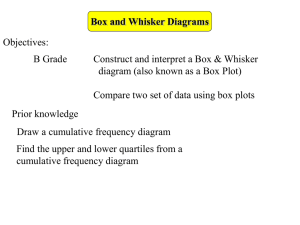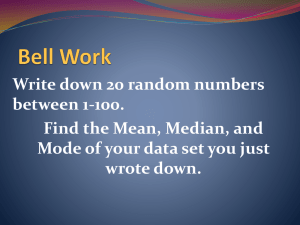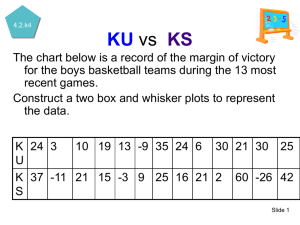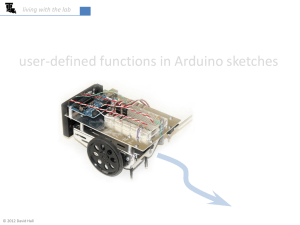4 Box and Whisker Diagrams
advertisement
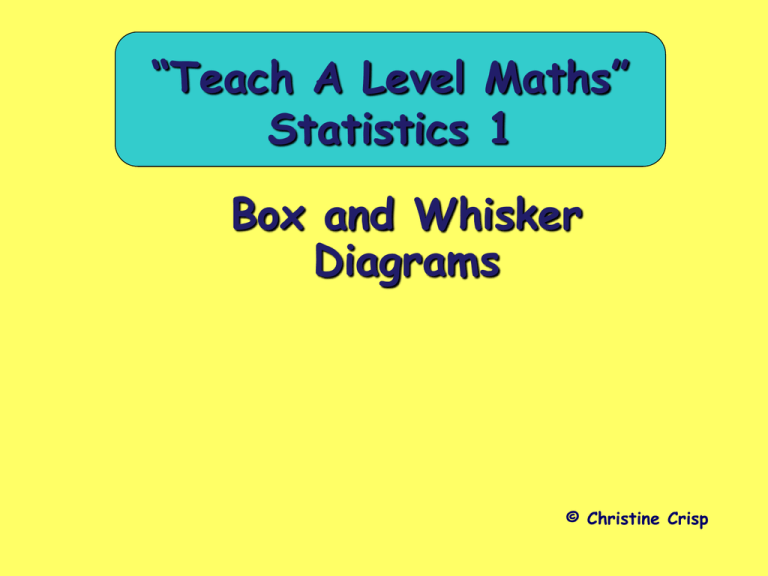
“Teach A Level Maths” Statistics 1 Box and Whisker Diagrams © Christine Crisp Box and Whisker Diagram Statistics 1 AQA EDEXCEL MEI/OCR OCR "Certain images and/or photos on this presentation are the copyrighted property of JupiterImages and are being used with permission under license. These images and/or photos may not be copied or downloaded without permission from JupiterImages" Box and Whisker Diagram Box and Whisker diagrams use 5 measures from a frequency distribution: the lowest and highest values, the median and the lower and upper quartiles. They are very quick to draw and show the main features of the distribution. Box and Whisker diagrams are sometimes called box plots. Box and Whisker Diagram The diagram can easily be drawn using a cumulative frequency diagram. I’ll use the age data from the previous presentation. The box can be any depth. The projected population of the U.K. for 2005 ( by age ) minimum One The box median upper age lower whisker quartile quartile The other maximum whisker age Box and Whisker Diagram The diagram can easily be drawn using a cumulative frequency diagram. I’ll use the age data from the previous presentation. minimum age The projected population of the U.K. for 2005 ( by age ) lower median upper quartile quartile maximum age Box and Whisker Diagram The diagram can easily be drawn using a cumulative frequency diagram. I’ll use the age data from the previous presentation. The projected population of the U.K. for 2005 ( by age ) We need a scale. 0 50 Age (years) 100 Box and Whisker Diagram Box and whisker diagrams are very useful for comparing data sets. e.g. The following diagrams represent the rainfall in the first 16 days of March 2004 in 20 regions of the UK and of France: Rainfall in UK Rainfall in France • The median rainfall was higher in France. Box and Whisker Diagram Box and whisker diagrams are very useful for comparing data sets. e.g. The following diagrams represent the rainfall in the first 16 days of March 2004 in 20 regions of the UK and of France: Rainfall in UK Rainfall in France • The range of rainfall amounts is greater in the U.K. . . . Box and Whisker Diagram Box and whisker diagrams are very useful for comparing data sets. e.g. The following diagrams represent the rainfall in the first 16 days of March 2004 in 20 regions of the UK and of France: Rainfall in UK Rainfall in France • The range of rainfall amounts is greater in the U.K. . . . but the interquartile range ( giving the middle 50% of amounts ) is greater in France. ( The IQR is a better measure than range as it ignores extreme values. ) Box and Whisker Diagram Box and whisker diagrams are very useful for comparing data sets. e.g. The following diagrams represent the rainfall in the first 16 days of March 2004 in 20 regions of the UK and of France: Rainfall in UK Rainfall in France • Three quarters of the areas of the UK had less than 22 mm compared with 37 mm for France Box and Whisker Diagram SUMMARY A box and whisker diagram uses 5 values: The lower quartile, median and upper quartile form the box which shows the central 50% of values. upper quartile lower quartile median The least and greatest data values give the ends of the whiskers. 0 50 There must be a scale. 100 Box and Whisker Diagram Skewness Some sets of data are almost symmetrical. For a symmetrical data set, the box and whisker diagram is also symmetrical and the mean and median are close together. A data set that is not symmetrical is said to be skewed. e.g. This data set is positively skewed. Data sets with the tail to the right are positively skewed. Data sets with the tail to the left are negatively skewed. Box and Whisker Diagram Comparing data sets of different sizes If we want to compare data sets which have different numbers of items, we draw the depths of the boxes in proportion to the sizes of the data sets. e.g. Suppose one set of data has n = 60 and a 2nd set has n = 45. If the depth of the 1st box is 1 cm, we make the depth of the 2nd box equal to 3 45 3 1 cm 4 4 60 Box and Whisker Diagram Outliers An outlier is an observation that lies beyond the limits of most of the data. It may be the result of an error or just represent an unusual observation. Outliers will not affect the median and interquartile range but can distort other measures of location and spread. Outliers are sometimes shown on box and whisker diagrams by using a broken line. e.g. 0 50 100 150 Box and Whisker Diagram Outliers There isn’t one hard and fast rule to identify outliers. However, we sometimes say that any observation less than 1·5 IQR below the LQ or more than 1·5 IQR above the UQ is an outlier. e.g Consider the data 4 7 10 11 13 17 21 25 28 32 56 We have LQ = 10, UQ = 28 and IQR = 28 – 10 = 18 So, 1·5 IQR = 27 and UQ + 27 = 55 Using this rule, 56 is an outlier. ( We can see without calculations that 4 is not an outlier. ) Box and Whisker Diagram Exercise The box and whisker diagrams show the heights of a sample of year 8 boys and girls. Girls Boys Source: CensusAtSchool What conclusions can you draw from the diagrams? Box and Whisker Diagram Girls Boys • The median girl is about 3 cm taller than the median boy. • The interquartile range is similar so the spread of heights is similar. • The shortest 25% of girls have a greater variability of heights than the shortest 25% of boys. ( Other answers are possible. ) The following slides contain repeats of information on earlier slides, shown without colour, so that they can be printed and photocopied. For most purposes the slides can be printed as “Handouts” with up to 6 slides per sheet. Box and Whisker Diagrams SUMMARY A box and whisker diagram uses 5 values: The lower quartile, median and upper quartile form the box which shows the central 50% of values. upper quartile lower quartile median The least and greatest data values give the ends of the whiskers. 0 50 There must be a scale. 100 Box and Whisker Diagrams Box and whisker diagrams are very useful for comparing data sets. e.g. The following diagrams represent the rainfall in the first 16 days of March 2004 in 20 regions of the UK and of France: Rainfall in UK Rainfall in France Rainfall (mm) • The median rainfall was similar in the 2 countries. • There is much greater variation in the UK rainfall. • Three quarters of the areas of the UK had less than 22 mm compared with 32 for France Box and Whisker Diagrams Skewness Some sets of data are almost symmetrical. For a symmetrical data set, the box and whisker diagram is also symmetrical and the mean and median are close together. A data set that is not symmetrical is said to be skewed. e.g. This data set is positively skewed. Data sets with the tail to the right are positively skewed. Data sets with the tail to the left are negatively skewed. Box and Whisker Diagrams Outliers There isn’t one hard and fast rule to identify outliers. However, we sometimes say that any observation less than 1·5 IQR below the LQ or more than 1·5 IQR above the UQ is an outlier. e.g Consider the data 4 7 10 11 13 17 21 25 28 32 56 We have LQ = 10, UQ = 28 and IQR = 28 – 10 = 18 So, 1·5 IQR = 27 and UQ + 27 = 55 Using this rule, 56 is an outlier. ( We can see without calculations that 4 is not an outlier. )
